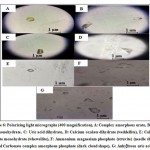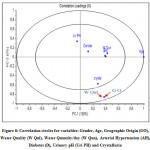How to Cite | Publication History | PlumX Article Matrix
Mohamed Bouha1,2 , Malika Echajia1*
, Malika Echajia1* , Souad Mojahidi1
, Souad Mojahidi1 , Younes Aassem1
, Younes Aassem1 , Mustapha Oubenali1
, Mustapha Oubenali1 , Tarik El Ouafy3
, Tarik El Ouafy3 , Mohamed Berkani2
, Mohamed Berkani2 and Mohamed Mbarki1
and Mohamed Mbarki1 .
.
1Team of Analytical and Computational Chemistry, Nanotechnology and Environment, Faculty of Science and Technics, Sultan Moulay Slimane University, BeniMellal, Morocco.
2Laboratory of Spectrochemistry and Chemometrics, Science and Technologies Faculty, Sultan Moulay Slimane University, Beni-Mellal, Morocco.
3Team of Analytical and Computational Chemistry, Nanotechnology and Environment, Sultan Moulay Slimane University, Polydisciplinary Faculty, Khouribga, Morocco.
Corresponding Author E-mail: m.echajia@uca.ac.ma
DOI : http://dx.doi.org/10.13005/bbra/2919
ABSTRACT: Urolithiasis presents an ascending prevalence in several countries around the world. The purpose of the present work is to achieve a fast and robust approach to the multiple factors influencing the chemical profile of human crystalluria and therefore in promoting the development of urinary calculi. From February to July 2018, 148 morning urine samples have been collected from 148 patients at the BeniMellal Regional Hospital Center in Morocco. An observation by Polarizing Light Microscopy allowed us to detect the chemical profile of crystalluria.A classification by the Principal Components Analysis (PCA) method has been applied to the individuals that are 148 crystalluria samples and to nine factors that are: ''gender'', ''age'', '' geographical area '', '' water quality'', ''water amount per day '', ''personal and family history'', ''urinary pH'', ''presence of crystals'' and ''chemical profile''. The first results of the principal components analysis (PCA) method shows that there are similarities between crystalluria samples and more or less strong correlations, between some of the nine factors that can influence crystalluria. The frequency of majority constituents in crystalluria is age dependent and oxalic-calcium is the frequent chemical species for both genders. The study of crystalluria would be an excellent laboratory test that brings many benefits for the diagnosis and management of renal pathologies of crystalline origin.One can conclude that urolithiasis is multifactorial, various factors may increase the risk of urinary stone formation.
KEYWORDS: Crystalluria; Chemical profile; polarizing light microscopy; principal components analysis; whewellite; weddellite
Download this article as:| Copy the following to cite this article: Bouha M, Echajia M, Mojahidi S, Aassem Y, Oubenali M, Ouafy T. E, Berkani M, Mbarki M. Approach to Determine Crystalluria Influencing Factors in the Beni Mellal-Khenifra Area in Morocco, by Data Analysis. Biosci Biotech Res Asia 2021;18(2).. |
| Copy the following to cite this URL: Bouha M, Echajia M, Mojahidi S, Aassem Y, Oubenali M, Ouafy T. E, Berkani M, Mbarki M. Approach to Determine Crystalluria Influencing Factors in the Beni Mellal-Khenifra Area in Morocco, by Data Analysis. Biosci Biotech Res Asia 2021;18(2). Available from: https://bit.ly/3DmZW5w |
Introduction
Urine is an environment with constant supersaturation of one or more crystalline species; so, it is not unusual to find crystals1.Urinary crystals or crystalluria as medicallyis the presence of the crystals in the urine as sediment. This condition can be seen from the urine analysis in the clinical laboratory2.The search for crystalluria and morphologic analysis of urinary crystals is of interest in the diagnostic evaluation and assessment of efficacy of therapeutic strategies in stone formers3.
The objective of the present work is to approach both possible similarities between patients and correlations between factors that may influence the frequency of crystalluria in these patients.The geographical area, where this study has been conducted, is the of BeniMellal-Khenifraarea located between central and northern Morocco. The crystalluria samples were collected from patients at the Regional Hospital Center in this area.
The chemical profile of the crystalluria has been determined by means of polarizing light optical microscopy and the search for possible correlations between different studied factors has been carried out using the principal components analysis method. These factors are: “gender”, “age”, “geographical area”, “water quality”, “daily water intake”, “personal and family history”, “urine pH”, “presence of crystals” and “chemical profile”.
Material and methods
The study of crystalluria has been carried out on 148 patients presenting positive crystalluria who were hospitalized in the urology department of the Moroccan Regional Hospital Center, Morocco within the February to June 2018 period.Urine specimen collection involved morning urine from each patient at it woke up. Approximately 50 ml of such urine is taken from a sterilized vial and stored at a 4°C temperature in the refrigerator. The urinary pH is noted in situ while the observation of the urinary crystals under a polarizing light optical microscope has been done in the laboratory within a period of no more than 2 hours. A patient questionnaire was undertaken in terms of the data to be processed by this work.The data from the questionnaire were completed and adjusted using data and archives from the databases of the Beni Mellal-Khenifra Regional Hospital Center.
We determined the following characteristics: “gender”, “age”, “geographic area”, “water quality”, “daily water intake”, “personal and family history”, “urine pH”, “presence of crystals” and “chemical profile”. A urine analyzer was used for the measurement of the urine pH (pHur) and of the observation of crystalluria has been observed by polarizinglight optical microscopy. A classification by the Principal Components Analysis (PCA) method has been applied to the collected data through the questionnaire and archives atthe BeniMellal-Khenifra Regional Hospital Center.
Result and Discussion
Results
Distribution of patients by gender and age
In this 148 patients seriespresenting positive crystalluriathe mean age is 47 years, 86 females (58.1%) compared to 62 males (41.9%) (Figure 1) (The male to female ratio was 0.7). This ratio has been further decreased in subjects younger than 40 years old (M/F=0.6) and subjects between 40 and 60 years old (M/F=0.4). Male dominance was evident above the 60 years age, with an overall male/female (M/F) ratio of 1.2 (Figure1).
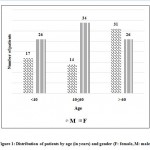 |
Figure 1: Distribution of patients by age (in years) and gender (F: female, M: male). |
Distribution of patients by geographical origin and water quality
We have identified the geographical origin of the 148 patients at the BeniMellal-Khenifraarea: 33% come from urban zones (U) and 67% from rural zones (R) (Figure 2).We identified the quality of the consumed water by 148 patients at the site of this work.The general resultis that 34% of the patients use the treated water (TW) while 66% use the untreated one (UW) (Figure 2).
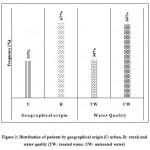 |
Figure 2: Distribution of patients by geographical origin (U: urban, R: rural) and water quality (TW: treated water, UW: untreated water). |
Distribution of patients according to daily water intake (Liter /Day)
The results show that 95% of patients consume no more than 2L/day (Figure 3).
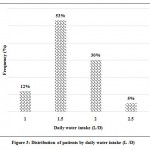 |
Figure 3: Distribution of patients by daily water intake (L /D). |
Distribution of patients by disease of diabetes and hypertension diseases
The present work concerned a population of diabetics and patients with arterial hypertension. Of the 148 patients (presenting positive crystalluria), 30% are diabetic (D) and 16% present arterial hypertension (AH) (Figure 4).
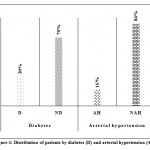 |
Figure 4: Distribution of patients by diabetes (D) and arterial hypertension (AH). |
The results obtained show that half of the population of 44 diabetics were women: they represented 52% of the total population (the male/female ratio was 1.1).
Concerning the hypertension disease, the majority of the 24 patients were men: they represented 71% of the total number of patients (the male/female ratio was 2.4).
Distribution of patients by urinary pH (pHur)
In the present work, we measured the urinary pH value (pHur) of the 148 patients. The obtained result showed a predominance of a 5.5 pH (Figure 5).
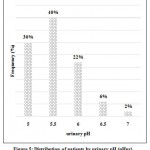 |
Figure 5: Distribution of patients by urinary pH (pHur). |
Distribution of majority constituents by age and gender
Micrographs, by polarizing light optical microscopy (PLOM), of encountered crystalluria examples show: calcium oxalates, uric acids and calcium phosphates (Figure 6).In fact, these crystalline species have different facies in the urine. Weddellite is commonly crystallizing as octahedral crystals composed of two flattened pyramids joined at the base. These crystals thus appear as square envelopes in the urine at the perspective view when they are observed under the PLOM (Figure 6).
The results of the study of crystalluria were expressed in terms of number and frequency (%) according to the chemical nature of the majority crystalline species and according to the gender and the age of the patients (Tables 1 and 2). Analysis of these two tables shows that, overall, the oxalo-calcium (Ox-Ca) nature is predominant in all age classes in both two genders.
Table 1: Frequency distribution of the major component of crystalluria by age in males (N = 62): Calcium oxalate monohydrate (whewellite) (COM), Calcium oxalate dihydrate (weddellite) (COD), Uric acid monohydrate (UAM), Uric acid dihydrate (UAD), Anhydrous uric acid (AnUA), Amorphous complex urate (ACU), Amorphous carbonate complex phosphate (ACCP) and Ammonium magnesium phosphate (AMP).
| Age class (years) | Number (%) | Calcium Oxalates | Uric acid and urates | Phosphates | |||||
| COM | COD | UAM | UAD | AnUA | ACU | ACCP | AMP | ||
| <18 | 7 (6,3) |
2 (28,6) |
2 (28,6) |
– | 2 (28,6) |
– | 1 (14,2) |
– | – |
| 18 – 40 | 31 (27,7) |
9 (29) |
9 (29) |
1 (3,2) |
5 (16,2) |
1 (3,2) |
5 (16,2) |
1 (3,2) |
– |
| 40 <age ≤ 60 | 37 (33) |
13 (35,1) |
10 (27) |
2 (5,4) |
7 (19) |
1 (2,7) |
2 (5,4) |
2 (5,4) |
– |
| > 60 | 37 (33) |
13 (35,1) |
11 (29,7) |
– | 7 (19) |
2 (5,4) |
3 (8,1) |
1 (2,7) |
– |
| Total by constituent | 112 (100) |
37 (33) |
32 (28,6) |
3 (2,7) |
21 (18,7) |
4 (3,6) |
11 (9,8) |
4 (3,6) |
– |
| Total by chemical class of constituent | 69 (61,6) |
39 (34,8) |
4 (3,6) |
– | |||||
Table 2: Frequency distribution of the major component of crystalluria by age in Females (N = 86): Calcium oxalate monohydrate (whewellite) (COM), Calcium oxalate dihydrate weddellite) (COD), Uric acid monohydrate (UAM), Uric acid dihydrate (UAD), Anhydrous uric acid (AnUA), Amorphous complex urate (ACU), Amorphous carbonate complex phosphate (ACCP) and Ammonium magnesium phosphate (AMP).
| Age class (years) | Number
(%) |
Oxalates de Calcium | Acideurique et urates | Phosphates | |||||
| COM | COD | UAM | UAD | AnUA | ACU | ACCP | AMP | ||
| <18 | 11 (10,5) |
3 (27,3) |
3 (27,3) |
1 (9,1) |
2 (18,1) |
1 (9,1) |
1 (9,1) |
– | – |
| 18-40 | 24 (22,9) |
9 (37,5) |
4 (16,7) |
1 (4,2) |
5 (20,8) |
2 (8,3) |
1 (4,2) |
2 (8,3) |
– |
| 40<age ≤ 60 | 54 (51,4) |
20 (37) |
15 (27,7) |
1 (1,9) |
11 (20,3) |
1 (1,9) |
4 (7,4) |
1 (1,9) |
1 (1,9) |
| > 60 | 16 (15,2) |
7 (43,7) |
2 (12,5) |
– | 3 (18,7) |
1 (6,3) |
1 (6,3) |
– | 2 (12,5) |
| Total by constituent | 105 (100) |
39 (37,1) |
24 (22,8) |
3 (2,9) |
21 (20) |
5 (4,7) |
7 (6,7) |
3 (2,9) |
3 (2,9) |
| Total by chemical class of constituent | 63 (60) |
36 (34,3) |
6 (5,7) |
||||||
Classification by the principal componentsanalysis (PCA) method
The Figure 7 shows the factor map of individuals in three dimensions. It allows the visualization of the projections of the points corresponding to the 148 patients on the first three main components. We have determined three classes of the patients
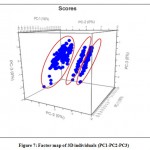 |
Figure 7: Factor map of 3D individuals (PC1-PC2-PC3). |
The following Figure 8 shows the circles of correlations between the nine studied factors.
Discussion
The analysis of these crystalluria of apatient’s series from the Moroccan Middle Atlas shows a relative female predominance with a0.7 M/F ratio (Figure 1). This report is not consistent compared to several previous works4, 5. This can be explained by the fact that the choice of patients in the present work was arbitrary and within an arbitrary period of time.
The prevalence of crystalluria varies according to age.In our study, patients over 40 years showed a high rate of crystalluria compared with that of the other age groups (Figure 1).This is concordant with the higher frequency of crystalluria observed in normal adults aged 40 years and above in a cross-sectional study6.
One aspect that has received very little attention is the variation of the composition of urine according to geographical areas within the same area (Figure 2). Our results also show a higher frequency in patients from rural zones. This result may be related to the fact that the studied area presents an agricultural vocation.
Beverage waters differ according to their characteristics, temperature, flow rate and hydrogeological origin of the water. In addition, most zones of the BeniMellal-Khenifraarea lacks drinking water treatment plant.
The results of this study show a higher frequency in patients consuming untreated water (UW) (Figure 2).There is a strong correlation between the geographical origin of the patient and the quality of the consumed water. In fact, treated water plants are more common in urban zones than in rural ones (Figure 2).
Results from our series show that 95% of patients consume no more than 2L/day (Figure 3).The daily ration should be increased until between 2.5 and 3 L in order to ensure a urine output of more than 2 L per day7. However, even individuals consume 2.5 L/D they can present positive crystalluria. This can be explained by the fact that the latter depends on other parameters such as the quality of the consumed water,and non-appropriated dietary habits.It should be noted that almost all patients have a below-standard fluid intake. Also, this is a factor favoring the presence of crystalluria.
The prevalence of crystalluria in the urine of diabetics (30%) was lower than that found in nondiabetics (Figure 4). However, these results disagree with the study of Ephraim, R. K. et al.6that shows a prevalence of a 17.5 % crystalluria in diabetic patients compared to 5% in non-diabetic ones8. Formation of crystals in the urine of such individuals increases with increasing blood glucose and decreasing urine pH. Good glycemic control may reduce the occurrence of crystals in urine. The study of crystalluria could be useful to detect this risk and to propose preventive measures. Complementary studies are necessary to identify factors accounting for the increased risk of crystalluria in diabetic patients and to verify whether good glycaemic control can reduce the crystallogenic risk.
Arterial hypertension (AHT) is a major cardiovascular risk factor in the occurrence of stroke, heart failure, renal insufficiency and coronary heart disease, which are the leading causes of death worldwide9.In our study, crystalluria is a rare entity in patients with Arterial hypertension. In this context, it should be pointed out that few studies have been carried out on the correlation between crystalluria and high blood pressure. The present study does not show a link between crystalluria and hypertension.
The study was consecrated to detect the impact of the urine pH on the crystalluria. In fact, the crystal formation has been influenced by boththe urine pH and the samples collection. The present study also shows a higher frequency of a 5.5 pH(Figure 5). This value is close to the average value of normal urine pH (pH=5.8)10.The changing of urine pH can also induce the urolithiasis formation of calcium oxalate, calcium carbonate, and magnesium ammonium phosphate (triple phosphate) crystals11, 12.
There are few pH-independent crystalline species present in urine. These are mainly calcium oxalates, dihydroxyadenine, cholesterol (rare in urine) and rarely cystine.In fact, even calcium oxalate and cystine are partly pH-dependent, but in the usual pH range of urine, their sensitivity to pH can be considered low13.
The interpretation of crystalluria, based on the analysis of certain criteria taken in isolation or in addition to other factors such as urinary pH, allows the detection of certain urinary biochemical abnormalities involved in the processes of formation of common lithiasis13.
It can be seen that even patients with normal urine pH also have positive crystalluria (Figure 5).This can be explained by the fact that usually the urinary pH (pHur) would be non dependent on the presence of crystalluria. Moreover, the determinants of urinary pH are not fully known and associate the organic factors with the dietary ones.
The oxalo-calcium, as a major chemical character, comes from the calcium oxalate monohydrate (COM) (whewellite) and calcium oxalate dihydrate (COD) (weddellite) (Figure 6: D and E) with a 61.6% frequency in men and 60% in women, identical results were reported by another study in Morocco14. The second most common chemical character in men (Table 1) and women (Table 2) is related to purines. In fact, these last chemical pieces have been detected as uric acid monohydrate (UAM), uric acid dihydrate (UAD), anhydrous uric acid (AnUA) and complex amorphous urate (CAU) with a 34.8% frequency in men and 34.3% in women. The phosphate character appears as carbonate complex amorphous phosphate (CCAP) with a 3.6% frequency in men while in women this character appears as CCAP and also as ammonium magnesium phosphate (MAP) with a 5.7% frequency.Indeed, some studies conducted in the same geographical BeniMellal-Khenifra area, have linked the relatively high frequency of calcium oxalate monohydrate (COM) to the dietary habits of populations14, 15, 16. It has been reported by Oussama et al.thatan inhibiting effect of the citrus juices on the crystallization of calcium oxalate.
Furthermore, it should be noted that according to the age (Tables 1 and 2), the proportion of oxalo-calcium compounds in urine increases more and more. This can be explained by the decrease in kidney function after the age.By comparing the two genders, analysis of the results shows that the presence of crystals in urine in men is predominant for the over 40 years age groups, while in women it is common for the between 41 and 60 years age groups. These results are closer to those of M. Mbarki et al.17who have reported that the presence of crystals in urine in both genders is predominant in the 40-60 age group. In Iraq, a study was conducted on the types of crystals observed in a group of patients aged 9 to 60 years, in which no significant difference was found in the frequency of crystalluria in different age groups18.
It should be noted that the gender and age of the patient are very important factors, as has already been shown in several studies of crystalluria19, 20, 21.
According to the factor map of individuals(Figure 7), we can see that individuals can be divided into three or four classes so that each one contains both women and men. The gender factor of the patients seems to have no impact on the presence of crystalluria. However, this result does not explain the fact that urinary lithiasic disease is male-dominated as reported in previous work17,22.The presence of crystals in the urine usually indicates the composition of the kidney stones23, 24. In fact, the presence of crystalluria does not necessarily mean that the patient develops urinary calculi, although the team of Nadia Messaoudi25, in Oran has shown a correlation, in terms of chemical nature, between urinary calculi on the one hand and crystalluria on the other hand.The factor map of individuals (Figure 7) shows a slight discrimination between the crystalluria of young and old patients. Moreover, the crystalluria of children is different from that of other patients. This result is in agreement with the work ofPrabhu et al., in India4.
Based on the correlation circles of the nine studied factors (Figure 8), the following predictions can be made:
There is a strong correlation between the geographical origin of the patient, the quality of the consumed water and the presence of crystalluriain the patient urine; Also, one can observe a strong correlation between these three factors on the one hand and the age of the patients on the other hand. In fact, these results are consistent with those of the distribution of crystalluria according to the age group of patients. The older age groups are more predisposed to present positive crystalluria.
The present study reports some correlation between the disease of diabetes and hypertension on the one hand and the frequency of crystalluria on the other hand. It should be noted that Mbarki M. et al.17reported a uric chemical profile in women presentingdiabetes. Only few studies have been carried out on the possible dependence between hypertension and crystalluria or lithiasic.
In addition, the present work detected a weak correlation between the urinary pH and other factors such as crystalluria, geographical origin of the patient and quality of consumed water.
Conclusion
The study of crystalluria is an excellent routine laboratory test that provides useful information for the diagnosis and management of renal pathologies of crystalline origin. The objective of the present work is to determine the risk factors of crystlluria in patients from the BeniMellal-Khenifra area in Morocco.
As it can be concluded that there was a strong relationship between crystalluria and the different parameters studied. The frequency of positive crystalluria was higher in the urine of the aged patients. Polarizing light optical microscopy coupled with principal component analysis would be a rapid, low cost and robust approach to the multiple factors influencing the chemical profile of human crystalluria and therefore in promoting the development of urinary calculi. Unlike the gender factor of the patients, the factor of their age, water quality and geographical origin have a direct impact on the presence of crystalluria and its chemical nature. Furthermore, urinary pH does not appear to be directly related to the frequency of crystalluria.In addition to the climatic factors of the geographical area, it seems that the population has particular dietary habits that require further investigation that are currently in study progress, to be able to confirm their involvement in lithiasic processes.
Acknowledgment
Our thanks to the Management of the BeniMellal Regional Hospital Center, Morocco.
Conflict of interest
The authors declare that they have no conflicts of interest.
Funding Source
Any institution does not fund this research paper and the resources of our research laboratory are very limited.
References
- , Daudon M. Clinical value of crystalluria and quantitative morphoconstitutional analysis of urinary calculi. International Journal of Surgery. 2016 ; 36 : 624-632.
CrossRef - Fitriyani F., Wardi V. Risk Factors Related to the Crystalluria Case among Workers at Welding Department Of Automotive Industry X Jakarta. In AIPHC 2019: Proceedings of the Third Andalas International Public Health Conference, AIPHC 2019, 10-11th October 2019, Padang, West Sumatera, Indonesia. European Alliance for Innovation. 2020 : 121.
CrossRef - Daudon M., Frochot V., Bazin D.,Jungers P. Crystalluria analysis improves significantly etiologic diagnosis and therapeutic monitoring of nephrolithiasis. Comptes Rendus Chimie. 2016 ; 19(11-12) : 1514-1526.
CrossRef - Prabhu N., Marzuk M., Uma A.,Sarada V. Comparative analysis of bacterial pathogens and crystalluria in cases enrolled in a tertiary care teaching Hospital, Tiruchirapalli, India. 2015 ; 2(3) : 342-352.
CrossRef - Prabhu N., Marzuk S. M. M., Banthavi S. P., Sundhararajan A., Uma A., Sarada V. Prevalence of crystalluria and its association with Escherichia coli urinary tract infections. International Journal of Research in Medical Sciences. 2015 ; 3(5) : 1085.
CrossRef - Ephraim R. K., Brenyah R. C., Osei R., Bossipe B. D., Adoba P., Osakunor D. N., Agbodzakey H. Crystalluria in HIV/AIDS patients on highly active anti-retroviral therapy in the Kumasi metropolis; a cross sectional study. Nigerianmedical journal : journal of the Nigeria Medical Association. 2014 ; 55(6): 504.
CrossRef - Tack I., Hébel P., Fantino M. Could drinking enough water protect our kidneys?. Notebooks of Nutrition and Dietetics. 2016; 51(4):204-210.
CrossRef - Ephraim R. K. D., Anoff K. A., Brenyah R. C., Osakunor D. N. M., Sakyi S. A., Osei-Yeboah J., Anto E. O. Determinants of crystalluria among type 2 diabetes patients; A case-control study of the Agona West Municipality, Ghana. Nigerianmedical journal: journal of the Nigeria Medical Association. 2017 ; 58(3) : 114.
CrossRef - Mabele G. K., Ekisawa C. N., Delecluse C., Bompeka F. L., NkodilaNatuhoyila A. Évaluation de la prévalence de l’hypertension artérielle de l’adulte en milieu du travail à Kinshasa, République Démocratique du Congo. Science and Sports. 2018 ; 33(4) : 213-220.
CrossRef - Carlos R. J., Ramón G. T., Lars B., Miguel A. L., Catharina W., Tamara H., and al. Heat stress nephropathy from exercise-induced uric acid crystalluria: a perspective on Mesoamerican nephropathy. American Journal of KidneyDiseases. 2016; 67(1): 20-30.
CrossRef - Ali A., Mahmood A., Mohammad K. Comparative evaluation of urinary dipstick and pH-meter for cattle urine pH measurement. 2020; 6(2): e03316.
CrossRef - Ricardo V., Sarel V. A. Veterinary Clinics of North America: Food Animal Practice.2016;32(3): 687-700.
CrossRef - Daudon M. Cristallurie. Néphrologie et Thérapeutique. 2015 ; 11(3) : 174-190.
CrossRef - El Habbani R., Chaqroune A., Houssaini T. S., Arrayhani M., El Ammari J., Dami F.,Chouhani B. A., Lahrichi, A. Étude épidémiologique sur les calculs urinaires dans la région de Fès et sur le risque de récidive. Progrès en urologie. 2016 ; 26(5) : 287-294.
CrossRef - Rabi S., Echajia M., Tcheka C., Elhadiri N., Mbarki M. Study of crystalluria in goitrous patients. International Journal of Innovation and Applied Studies. 2015; 10 (2): 687-693.
- Oussama A., Touhami M., Mbarki M. In vitro and in vivo study of effect of lemon juice on urinary lithogenesis. ArchivosEspañoles de Urología. 2005; 58(10): 1.087-1.092.
CrossRef - Mbarki M., Jabrane J., Oussama A., Daudon M. Study of crystalluria in diabetic patients. Prog Urol. 2005; 15 (3): 420-426.
- Hassan J. Crystalluria types and incidence in Basra City; southern of Iraq. Journal of Basrah Researches (Sciences). 2011; 37 (5): 72-80.
- Fatma M. B. Etude de l’intérêt biologique et clinique de la cristallurie et détermination des inhibiteurs de l’agrégation des cristaux urinaires de type (whewellite, struvite et brushite) à partir des substances chimiques et naturelles (Doctoral dissertation, Universite Abdelhamid Ibn Badis Mostaganem). 2019.
- Tabibzadeh N., Zalc M., Michel T., Letavernier E., Mebazaa A., Borouchaki A.,Frochot,Daudon M., Haymann J. P.,Chousterman B. G. Prevalence and identification of crystalluria in critically ill patients: association between uric acid crystals and sepsis. Clinical kidney journal. 2021 ; 14(4) : 1291-1293.
CrossRef - Bailo P. S., González M. S., Álvarez S. I., Alonso R. L., Frago P. S., Flores J. L. B. A study of crystalluria : effectiveness of including hygienic-dietary recommendations in laboratory reports. Advances in Laboratory Medicine/Avances en Medicina de Laboratorio. 2021 ; 2(1) : 109-114.
CrossRef - Victoire L., Ferrari R., Erika, Daudon M., Porcher,Loze B., SauvageonH., MolinaJ. M. High levels of atazanavir and darunavir in urine and crystalluria in asymptomatic patients. Journal of Antimicrobial Chemotherapy. 2013; 68(8): 1850-1856.
CrossRef - Amaro M. M., Juncal L. C., Picone A. L., Della V., Carlos O., Romano R. M. Determinación de la composición de cálculosrenalespormétodosespectroscópicos. Journal of the Argentine Chemical Society. 2014 : 365-375.
- Patricia F., Irene R., Lourdes R., Jorge Z., Dominich G., Gloria E., Rosa G. Crystalluria in lithiasic children who attended to the Institute for Research in health Sciences in the period 2011-2013. Pediatría (Asunción). 2016 ; 43(2) : 123-128.
CrossRef - Messaoudi N., Sennour K., Daudon M., Omar Z. K., AttarA., Addou A. Prediction of successful treatment by extracorporeal shock wave lithotripsy based on crystalluria-composition correlations of urinary calculi. Asian Pacific Journal of Tropical Disease. 2015 ;5(12) : 987-992.
CrossRef

This work is licensed under a Creative Commons Attribution 4.0 International License.



